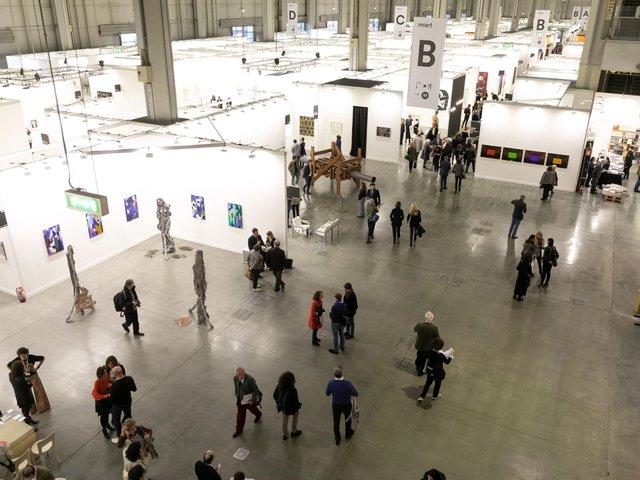“We have waited more than 30 years to introduce this measure,” announced the Italian politician Federico Mollicone at a lavish dinner held in Turin last Thursday (30 October). The event, attended by more than 500 guests, marked the 30th anniversary of the Fondazione Sandretto Re Rebaudengo set up by the popular local patron Patrizia Sandretto Re Rebaudengo.
Mollicone, who chairs the culture committee within Italy's chamber of deputies (the lower house of parliament), was referring to the decision made by the Italian parliament in June to reduce VAT on art sales from 22%, the highest rate in Europe, to 5%, its lowest. The decision, announced by prime minister Giorgia Meloni’s government, was a major boost for Italy which wants to improve the competitiveness of its art market, especially in the wake of a global slowdown.
The contemporary art fair Artissima, which held its 32nd edition in Turin last week, is the first Italian fair to test the waters following the tax overhaul. Unsurprisingly Italian dealers at the fair applauded the move, saying the impact is mostly positive.
“[The tax incentive] helps to close deals, it’s not as complicated as before,” said Thomas Brambilla of the eponymous Bergamo gallery which had sold seven works by the second day (31 October) including UK artist Maggi Hambling’s painting Wave Crashing III (2021), priced at €45,000. “It has not in a sense generated more sales but it has definitely sparked a different attitude among collectors,” said Mauro Nicoletti of the Rome-based gallery Magazzino.
“We’ve had our best opening day ever at Artissima,” said Alessandro Pasotti of the Bologna-based P420 gallery who stressed that the gallery had so far sold 30 works by artists such as Irma Blank and Adelaide Cioni, ranging in price from €5,000 to €40,000. “The tax change has helped considerably, not just selling to Italian collectors but also to Europeans.”
According to the veteran Turin dealer Franco Noero: “This fair is the first [tax] test, and [the new law] is a great achievement, but we need to look again at the effects in four to six months.” An unnamed Italian collector added: “These things come in cycles; let’s hope the government maintains this momentum and doesn’t change the legislation again [the law has passed through parliament in line with European Union law].”
Luigi Fassi, the fair director, says that the government understands what is at stake, arguing also that slashing VAT will not just “affect relations between dealers and collectors but also generate more money for artists. Galleries might be able to support more public institutions also.”
Asked about Artissima in the pecking order of fairs globally, Fassi says: “You might have said that we fit into the regional category [of fairs] but no, we are truly international with 60% of exhibitors [out of 176 in total] coming from abroad.” He added: “We focus solely on contemporary art… and [we present] the market with a human face. We don’t alienate the Italian middle-class; collecting is ingrained in Italian culture, our families have paintings on the walls of our apartments.”
International dealers at the fair this year include Thomas Dane of London, Jousse Entreprise of Paris and Lorenzo Ronchini of London who is selling a selection of paintings and sculptural installations by the late Japanese artist Katsumi Nakai. “Last year, the fair had a more national focus; this year it’s much more international”, said Ronchini.
Sales at the fair across the first two days were fairly brisk across all sections. In the main section, Romeo Paprocki of Paris sold three works by the German artist Simon Pasieka, ranging from €8,700 to €17,000, to a collection in Switzerland; Lugano-based Repetto gallery sold works to Italian collectors by artists such as Pietro Consagra, Jannis Kounellis and Pier Paolo Calzolari, priced between €3,000 and €180,000. In the “New Entries” section for first timers, Bremond Capela of Paris sold Madeline Peckenpaugh’s painting Windswept II, 2025 (€24,000).
P420, Thomas Brambilla and Magazzino all benefitted from the buying power of one of Italy’s most influential private philanthropic organisations, Fondazione Arte CRT—the philanthropic division of the former financial institution Banca CRT—which acquired 15 works at the fair for two of Turin’s most important institutions: Fondazione per l'Arte Moderna e Contemporanea CRT (GAM) and Castello di Rivoli.
The Fondazione Arte CRT has boosted the cultural credentials of Turin and the Piedmont region since it was founded in 2000; this year it increased its acquisitions fund to €300,000, the highest budget in 12 years. Works bought by the fund include David Schutter’s ANB C 1.03 series (2024) from Magazzino (€88,000) and Majd Abdel Hamid’s video work Muscle Memory III (2022) from P420. The Eye and the Ear (1945) by Franciszka and Stefan Themerson, sold by Import Export gallery of Warsaw, will join the collection of GAM.





